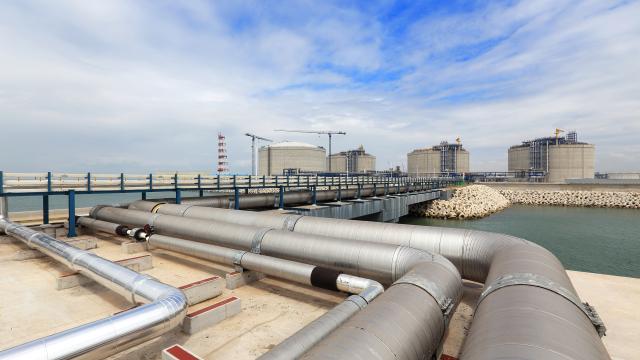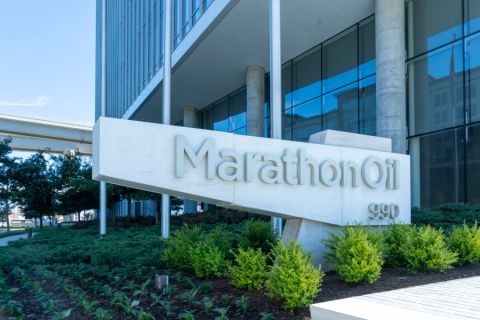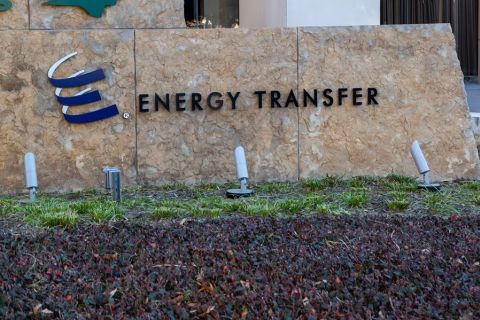
U.S. LNG exports are key to balancing the U.S. natural gas market, according to Bernadette Johnson, vice president, market intelligence, for Drillinginfo Inc.
“Natural gas production continues to reach record levels,” she told attendees at Hart Energy’s DUG Haynesville conference in February in Shreveport, La. Dry-gas production through year-end 2018 was 24.6 billion cubic feet per day (Bcf/d) more than in 2010, according to Drillinginfo data.
The U.S. Energy Information Administration (EIA) reported that November 2018 alone was the 19th consecutive month of dry-gas production year-over-year increases. The November total was more than 88 Bcf/d, up some 9 Bcf from the November 2017 daily output. Yet, Johnson noted that “storage inventories remained at historical lows throughout summer 2018.”
Working gas in storage entering withdrawal season Nov. 1 totaled 3.2 trillion cubic feet (Tcf), 15.3% lower, year-over-year, according to the EIA. Johnson said, “Demand for natural gas in the U.S. is increasing significantly. Some of it is domestic [consumption], but the biggest piece is LNG exports.”
Growth in exports to Mexico has been meaningful, she said, “but it’s not like LNG.”
Drillinginfo is expecting 11 Bcf/d of U.S. LNG exports by 2023, an estimate Johnson said “is conservative” based on what LNG developers forecast. “Ours is based on the market. How big is the market out there?
“The global LNG market that moves around on ships is a 40 Bcf/d market. It’s less than half the size of the U.S. [domestic market],” she said. “So can we grow to 11 [Bcf]? We think so. Can we grow much more than that? That’s pretty tricky. How are you going to replace or add more than 25% of the existing market? This is the challenge.”
The EIA forecast for LNG exports at year-end 2019 is 8.9 Bcf/d (with year-end 2018 estimated at 3.6 Bcf/d) as new trains come online at Elba Island, Ga. (Kinder Morgan Inc.); Freeport (Freeport LNG Development LLC) and Corpus Christi (Cheniere Energy Inc.), Texas; and Hackberry, La. (Cameron LNG LLC).
Drillinginfo estimates 2018 exports averaged 3.4 Bcf/d from two facilities: Cheniere’s Sabine Pass, La., export terminal and Dominion Energy Inc.’s terminal at Cove Point, Md.
Johnson said Drillinginfo data show January 2019 LNG exports set a record: 5.6 Bcf/d. The firm expects 2019 LNG exports will average 4.3 Bcf/d “as most [additional] facilities are not expected to be fully online until late 2019.” In 2020, exports are expected to jump to 6.5 Bcf/d.
“There’s some growth [in natural gas demand] on the power side,” she added, “but it’s not dramatic. The biggest, most impactful … more than anything [to demand] is LNG.”
Haynesville advantaged
Producers in all of the unconventional plays hope for a rise in natural gas demand—and gas prices—soon, but the Haynesville, more than other plays, depends on such a trend. The reborn play has multiple advantages, said Welles Fitzpatrick, but while markets have improved, they could be better.
Fitzpatrick, managing director of E&P research for SunTrust Robinson Humphrey, rated his firm “a little bit more optimistic on natural gas pricing” than many industry analysts. Also speaking at DUG Haynesville, he said, “Gas prices are depressed now, but we expect that to improve in 2019 and beyond. And when they do turn up, the Haynesville will be one of the best-positioned plays to take advantage of that upturn.”
That will drive corporate capital efficiency, “writ large,” he added, saying the play “will recapture its crown as the No. 1 gas play in the Lower 48.”
The difference between a bull market and a bear market—$3.50 gas vs. $2 gas—is a comparatively small swing of 2- to 4 billion cubic feet per day (Bcf/d) of demand, he said. Current U.S. dry-gas production runs above 87 Bcf/d.
Net gas exports, as LNG and to Mexico net after Canadian imports, will be the big driver of future demand, Fitzpatrick said. “The change is going up and up, by 2.1 Bcf/d in one year. That’s the equivalent of one Barnett [Shale]—that’s huge. It’s growing quicker than we expected. Industrial demand is positive, but the driver is exports.”
The most significant shift in gas demand came in 2016 when Cheniere’s Sabine Pass plant went on stream and “crystallized” the U.S. role as a major LNG supplier. “Now, we were supplying gas to the whole world.”
The Haynesville enjoys a location close to the Gulf Coast, near Sabine Pass and other LNG liquefaction plants, as well as comparatively good midstream infrastructure. Proposed pipelines will make that infrastructure still better.
Fitzpatrick said Haynesville gas is oversupplied now, but “this will reverse as production growth slows dramatically in ’19. Demand will accelerate this year and prices will respond positively as a result.” Longer term, the supply/demand situation looks good for producers in the Haynesville and elsewhere, he noted.
“We haven’t discovered a major new gas play since 2011,” Fitzpatrick said. “Shale plays don’t last forever, in fact they don’t last long. Without new plays, you need higher prices. The Haynesville is unique in its rebirth, which provides huge advantages.”
EIA figures show Haynesville gas production fell from above 6 Bcf/d to around 5 Bcf/d before starting a rebound in early 2017. Overall low prices and crowding from the Marcellus inhibited the play for a while. Late 2018 flows passed 8 Bcf/d.
Opportunity in abundance
Tom Petrie, chairman of Petrie Partners, seconded Fitzpatrick’s emphasis on gas exports. He pointed to the “LNG infrastructure solution that is so critical to transform the gas pricing marketplace.”
Petrie referred to a Massachusetts Institute of Technology gas production forecast published in 2010. It seemed optimistic at the time but in reality, “the productivity is more than twice what we thought we had.” The nation expanded from five to eight unconventional plays, and the Marcellus, “because it became so successful, so quickly,” gets credit for much of the increase, but the Appalachian play “became a competitive alternative to the Haynesville.”
Petrie described Cheniere’s announced plans nearly a decade ago to convert its LNG receiving terminal at Sabine Pass, La., to a liquefaction and export operation “the cornerstone” of LNG exports that transformed the U.S. gas business and the world’s LNG market. Cheniere founder Charif Souki, who made that bet, is now chairman of the board at Tellurian Inc.
Additional trains at Sabine Pass combined with the Cove Point, Md., Corpus Christi, Texas, and Cameron, La.; plants will push gas export demand to some 9 Bcf/d this year, he noted.
Petrie noted the gas supply overhang “is not a problem, it’s an opportunity.”
Exports represent an exciting opportunity for all of the shale plays. He mentioned the surging associated gas flowing out of the Permian Basin in particular. But the Haynesville’s proximity to many of the LNG liquefaction projects is a plus for the region’s producers.
“The implicit rising connectivity of Henry Hub to the global gas pricing trend is an exciting, transformational development for the U.S. fossil fuel sector generally, and especially for Haynesville production,” he said.
Recommended Reading
Oil and Gas Chain Reaction: E&P M&A Begets OFS Consolidation
2024-04-26 - Record-breaking E&P consolidation is rippling into oilfield services, with much more M&A on the way.
Exxon Mobil, Chevron See Profits Fall in 1Q Earnings
2024-04-26 - Chevron and Exxon Mobil are feeling the pinch of weak energy prices, particularly natural gas, and fuels margins that have cooled in the last year.
Marathon Oil Declares 1Q Dividend
2024-04-26 - Marathon Oil’s first quarter 2024 dividend is payable on June 10.
Talos Energy Expands Leadership Team After $1.29B QuarterNorth Deal
2024-04-25 - Talos Energy President and CEO Tim Duncan said the company has expanded its leadership team as the company integrates its QuarterNorth Energy acquisition.
Energy Transfer Ups Quarterly Cash Distribution
2024-04-25 - Energy Transfer will increase its dividend by about 3%.





